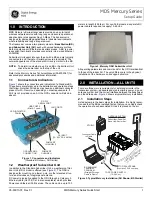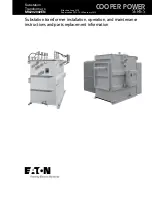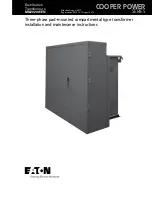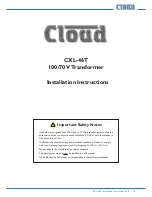
Instructions
F16LSC, F16LSCN
Installation Precautions
4
Read these instructions before using the gauge. Configuration may
be easier before installation. Contact the factory for assistance.
4
These products do not contain user-serviceable parts. Contact us
for repairs, service, or refurbishment.
4
Gauges must be operated within specified ambient temperature ranges.
4
Outdoor or wash down applications require a NEMA 4X gauge or
installation in a NEMA 4X housing.
4
Use a pressure or vacuum range appropriate for the application.
4
Use fittings appropriate for the pressure range of the gauge.
4
Due to the hardness of 316 stainless steel, it is recommended that
a thread sealant be used to ensure leak-free operation.
4
For contaminated media use an appropriate screen or filter to
keep debris out of gauge port.
4
Remove system pressures before removing or installing gauge.
4
Install or remove gauge using a wrench on the hex fitting only. Do
not attempt to turn gauge by forcing the housing.
4
Good design practice dictates that positive displacement liquid
pumps include protection devices to prevent sensor damage from
pressure spikes, acceleration head, and vacuum extremes.
p
Avoid permanent sensor damage! Do not apply vacuum to non-
vacuum gauges or hydraulic vacuum to any gauges.
p
Avoid permanent sensor damage! NEVER insert objects into
gauge port or blow out with compressed air.
Gauges are not for oxygen service. Accidental rupture of sensor
diaphragm may cause silicone oil inside sensor to react with
oxygen.
p
NEVER connect the gauge wires directly to 115 VAC or perma-
nent damage will result.
All operating power is supplied by the 4-20 mA current loop using
the 2-wire cable at the gauge rear. The F16LSC can be used as
an indicating transmitter in any 4-20 mA current loop or as a DC
powered gauge. Reversing the connections will not harm the gauge
but it will not operate with incorrect polarity.
Select a loop power supply voltage and total loop resistance so that
when the loop current is 20 mA, the gauge will have at least 10 VDC
at its terminals but not over 32 VDC.
For correct operation and to avoid erratic or erroneous readings, the
gauge terminal voltage must not fall below 10 VDC. Too large a loop
resistance will cause the gauge output to “limit” or saturate before
reaching its full 20 mA output. The minimum loop supply voltage
may be calculated from the formula:
V
min
= 10V + (20mA x Total loop resistance)
The F16LSC is designed for continuous operation. Warm-up time
is negligible.
When loop power is applied, the gauge will power-up automati-
cally. All active display segments are turned on for approximately
1 second.
After initialization, the gauge will begin operating in the Normal
Mode. The display will show the applied pressure. The loop cur-
rent and the Loop-Tracker
®
LED brightness will correspond to the
applied pressure.
The output is a 12,000 count analog 4-20 mA signal. The output
is filtered to improve noise immunity and is updated approximately
16 times per second.
Zero Tare, Push-To-Test, Configuration and Calibration modes are
accessible from the Normal Mode.
The power supply for the Backup Power mode recharges during
Normal Mode operation.
It takes approximately two hours of operation in the Normal Mode to
fully charge the backup power supply from the loop supply.
If loop power is lost, the gauge will automatically switch to the
Backup Power mode and continue to display the applied pressure
for 15 seconds.
Below are the 4-20 mA output values for various types of sensors,
assuming the output scale has not been adjusted.
Electrical Connection
Normal Operation
To use the transmitter as a low
voltage powered gauge connect it
to any 10-32 VDC power supply.
RED +
BLACK –
Power (+)
Power (–)
mA meter (–)
mA meter (+)
Power (–)
Power (+)
mA meter (+)
mA meter (–)
BLACK –
RED +
- or -
Power (–)
Power (+)
BLACK –
RED +
Sensor Range
Full
vacuum
“0” on
display
Full
pressure
Gauge reference pressure
n/a
4 mA
20 mA
Gauge reference vacuum
20 mA
4 mA
n/a
Compound –30inHg/15psi
4 mA
12 mA
20 mA
Compound –30inHg/100psi
4 mA
5.5 mA
20 mA
Compound –30inHg/200psi
4 mA
4.8 mA
20 mA
Absolute reference
4 mA
4 mA
20 mA
Bipolar ±
4 mA
12 mA
20 mA
cecomp.com
1220 American Way Libertyville, IL 60048
800-942-0315
CECOMP
Div. of
A
BSOLUTE
P
ROCESS
I
NSTRUMENTS
1.65"
2.88"
NEMA 4X
3.0"
2.0"
Turn at hex
fitting
only!
Turn at hex
fitting
only!
3 ft long,
2-conductor
22 AWG
cable
3 ft long,
2-conductor
22 AWG
cable
Select Test
Up Down
Numeric display
Alpha-numeric
display
Loop-Tracker
Red LED
¼" NPT
0.75"
SEL TEST
t
s
X X X X X
88888
2
Cecomp Electronics / Made in USA
3.38" Standard
3.5" NEMA 4X
Low loop
voltage
indicator
Dimensions
Range Codes
T
he gauge model range code indicates the default range. Alternate
default engineering units may be ordered.
Selectable Ranges
Engineering units may be changed to any of those listed in the same
row as shown in the table below.
Conversion
Engineering unit conversions are calculated from the factory default
unit to the newly selected units.
Ranges and Selectable Units
Sensor Range
and Units
psi
kPa
MPa
mbar
bar
atm
kg/cm
2
g/cm
2
mmH
2
O cmH
2
O
oz/in
2
ftH
2
O
inH
2
O
mmHg
torr
inHg
–14.7 to 15.0 psig
–14.7 to
15.0
–101.3 to
103.4
–.1013 to
.1034
–1013 to
1034
–1.013 to
1.034
–1.000 to
1.021
–1.033 to
1.055
–1033 to
1055
–1033 to
1055
–235.1 to
240.0
–33.90 to
34.61
–407 to
415
–760 to
776
–760 to
776
–29.92 to
30.54
–29.9 inHg to
15.0 psig
–14.7 to
15.0
–101.3 to
103.4
–.1013 to
.1034
–1013 to
1034
–1.013 to
1.034
–1.000 to
1.021
–1.033 to
1.055
–1033 to
1055
–1033 to
1055
–235.1 to
240.0
–33.90 to
34.61
–407 to
415
–760 to
776
–760 to
776
–29.92 to
30.54
–29.9 inHg to
100.0 psig
–14.7 to
100.0
–101 to
690
–.101 to
.690
–1.01 to
6.90
–1.00 to
6.81
–1.03 to
7.03
–235 to
1600
–33.9 to
230.7
–407 to
2767
–760 to
5171
–760 to
5171
–29.9 to
203.6
–29.9 inHg to
200.0 psig
–14.7 to
200.0
–101 to
1379
–.101 to
1.379
–1.01 to
13.79
–1.00 to
13.61
–1.03 to
14.06
–235 to
3200
–33.9 to
461.4
–407 to
5534
–29.9 to
407.2
0 to 3.000 psig
3.000
20.68
206.8
.2068
.2041
.2109
210.9
2109
210.9
48.00
6.921
83.0
155.1
155.1
6.108
0 to 5.000 psig
5.000
34.47
344.7
.3447
.3402
.3515
351.5
3515
351.5
80.0
11.54
138.4
258.6
258.6
10.18
15.00 to 0 psi abs
15.00 abs 103.4 abs .1034 abs 1034 abs 1.034 abs 1.021 abs 1.055 abs 1055 abs
1055 abs 240.0 abs 34.61 abs 415.1 abs 775.7 abs 775.7 abs 30.54 abs
0 to 14.70 psig vac 14.70 vac 101.3 vac .1013 vac 1013 vac 1.013 vac 1.000 vac 1.033 vac 1033 vac
1033 vac 235.1 vac 33.90 vac 406.8 vac 760 vac
760 vac
29.92 vac
0 to 15.00 psig
15.00
103.4
.1034
1034
1.034
1.021
1.055
1055
1055
240.0
34.61
415.1
775.7
775.7
30.54
30.00 to 0 psi abs
30.00 abs 206.8 abs .2068 abs 2068 abs 2.068 abs 2.041 abs 2.109 abs 2109 abs
2109 abs 480.0 abs 69.21 abs 830 abs
1551 abs 1551 abs 61.08 abs
0 to 30.00 psig
30.00
206.8
.2068
2068
2.068
2.041
2.109
2109
2109
480.0
69.21
830
1551
1551
61.08
0 to 60.00 psig
60.00
413.7
.4137
4137
4.137
4.083
4.218
4218
4218
960
138.4
1660
3103
3103
122.2
100.0 to 0 psi abs
100.0 abs 689.5 abs .6895 abs 6895 abs 6.895 abs 6.805 abs 7.031 abs 7031 abs
7031 abs 1600 abs 230.7 abs 2767 abs 5171 abs 5171 abs 203.6 abs
0 to 100.0 psig
100.0
689.5
.6895
6895
6.895
6.805
7.031
7031
7031
1600
230.7
2767
5171
5171
203.6
0 to 200.0 psig
200.0
1379
1.379
13.79
13.61
14.06
3200
461.4
5534
407.2
0 to 300.0 psig
300.0
2068
2.068
20.68
20.41
21.09
4800
692.1
610.8
0 to 500.0 psig
500.0
3447
3.447
34.47
34.02
35.15
1154
1018
0 to 1000 psig
1000
6895
6.895
68.95
68.05
70.31
2307
2036
0 to 3000 psig
3000
20.68
206.8
204.1
210.9
6921
6108
0 to 5000 psig
5000
34.47
344.7
340.2
351.5
Allow 1"
clearance
Allow 1"
clearance
Cecomp maintains a constant effort to upgrade and improve its products.
Specifications are subject to change without notice. See cecomp.com for
latest product information. Consult factory for your specific requirements.
WARNING:
This product can expose you to chemicals including
nickel and chromium, which are known to the State of Califor-
nia to cause cancer or birth defects or other reproductive harm.
For more information go to www.P65Warnings.ca.gov
Non-metallic system installations
require connecting gauge sensor to
earth ground to avoid static elec-
tricity damage to gauge.






















